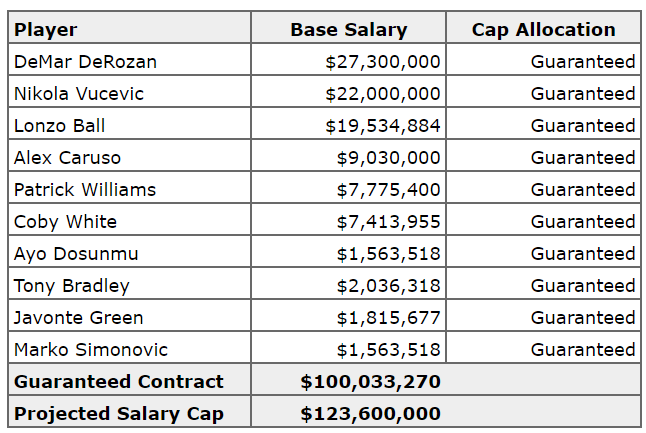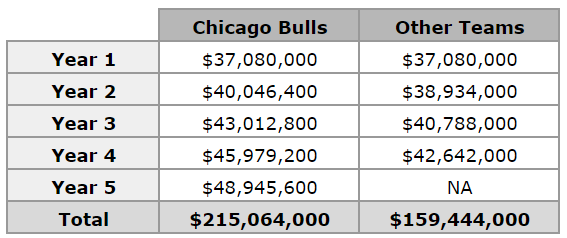© 2025 ALLCITY Network Inc.
All rights reserved.

Free Agency is here, friends!
As of 5 p.m. CT, the Chicago Bulls can officially begin to tinker with their roster. Expect some acquisitions to occur that address the current, obvious needs: 3-point shooting, rim protection, and more playable options at the forward positions.
It remains to be seen who the Bulls will add. Nabbing a few of the names from our top-15 free agent list would be nice. We’ll find out soon enough.
Until then, CHGO plans to get the reader prepped on some of the jargon and salary cap nuances you’re likely to hear over the coming days.
Salary Cap Projections
According to Tim Bontemps of ESPN, the NBA has increased its salary cap figures for the 2022-23 season. The new, projected figures will be:
- Salary Cap: $123.6 million
- Luxury Tax Line: $150.2 million
- Hard Cap / Apron: $156.9 million
The above figures are applicable to all 30 teams.
Teams that project to have total salaries above these numbers when free agency opens will not be able to add players via cap space. Instead, these team can only use ‘cap exceptions’ to add to their roster.
Should a team puts itself in a position where it is hard-capped (more on that later), these teams must remain below the hard cap line.
As it pertains to the Bulls, current reasonable projections have them operating as an ‘over-the-cap’ team, meaning they will be above the salary cap line ($123.6 million) when free agency opens.
Available avenues to add players
The most obvious way teams can add players in free agency is to use cap space. This offseason, only a select few teams are projected to have cap space e.g. Detroit Pistons, Indiana Pacers, San Antonio Spurs.
Those team which are operating over the cap — as we expect the Bulls to do — can only rely on cap exceptions to acquire talent.
Various forms of cap exceptions exist, all of which are designed to allow teams to add players, even when above the the cap. Available exceptions include:
Mid-Level Exception:
- Non-Taxpayer Mid-Level Exception (MLE): $10.49 million
- Tax-Payer Mid-Level Exception (TPMLE): $6.48 million
- Room Mid-Level Exception (RMLE): $5.40 million
As noted above, there are several variations of the mid-level exceptions. Teams will not have access to all three. Instead, only one can be used. The mid-level exception that will be granted to a team is entirely dependent on their cap position.
As it pertains to the Bulls, should they operate above the cap line ($123.6 million) and below the salary tax threshold ($150.2 million), they will gain access to the MLE.
This exception enables the Bulls to sign a player for up to four years, with 5% annual raises, on a base contract of up to $10.49 million in year one. Should the Bulls use this exception in its entirety, they could table a deal to a free agent which pays $45 million over four years.
The Bulls may have access to the MLE, but it remains to be seen if they use it in full. Doing so will likely push the franchise toward the luxury tax line. Instead, the Bulls are “expected to preserve room and not offer the full” MLE, according to Jake Fischer of Bleacher Report.
This is something to keep an eye on, as it may indicate the team is hesitant to use all possible avenues to build out the roster at the expense of luxury tax payments.
Bi-Annual Exception (BAE): $4.11 million
The league also allows teams to use a Bi-Annual exception to sign free agents. As the name suggests, this exception can be used only once every two years. Given the Bulls used this exception last season to sign Tristan Thompson (ugh), they will not have access the BAE this offseason.
Minimum Salary Exception: Contract value is based on years experience in the league, though teams will only be billed for $1.84 million against the cap sheet.
Beyond the MLE, the Bulls will be able fill the rest of their roster with minimum salaries.
Traded Player Exception (TPE): $5 million
The Bulls created a $5 million traded player exception when they sign-and-traded Daniel Theis to the Houston Rockets last offseason. This exception allows the Bulls to absorb up to $5 million in salary via trade. Free agents cannot be signed using a TPE.
Using the TPE likely will come down to ownership’s willingness to take on additional money, thus pushing the team into the luxury tax. As with the MLE, this is another key tool the Bulls can utilise to bolster their roster, assuming they’re want to pay to do so.
What is a hard cap?
The NBA and its salary cap structure operates within a ‘soft cap’ scheme. Essentially, this means there is a limit teams can spend, though it is possible to push beyond this number when re-signing its own players or using cap exceptions.
Should a team push beyond the salary cap line, they will be over the cap and, possibly headed toward paying the luxury tax to keep their roster intact.
Despite the NBA being governed by the soft cap, there are mechanisms within the rules which can force teams into a ‘hard cap’.
A team that is hard-capped will be forced to stay at-or-below a predetermined salary figure ($156.9 million) that, once triggered, cannot be crossed for any reason.
A hard cap can be triggered by one of three ways:
- Acquiring a player via a sign-and-trade
- Using the MLE
- Using the BAE
The Bulls were hard-capped last season as they executed sign-and-trade deals to acquire DeMar DeRozan and Lonzo Ball. As noted above, they also used their BAE last season on Tristan Thompson.
The Bulls will be hard-capped for the 2022-23 season if they use all of their MLE in free agency.
Bulls Cap Sheet
When free agency officially opens, the Bulls will have over $100 million owing in guaranteed contracts:

In addition to the above deals, the Bulls have a series of free agent ‘cap holds’ they must consider:

When combining the above figures together, it becomes clear why the Bulls will be operating as an above-the-cap team.
For those wondering what a cap hold is, in its most basic form, think of it as salary placeholder that counts against the cap sheet. This player and his salary will remain a cap hold until he signs a new contract or has his free agent ‘rights’ renounced.
Cap hold figures will vary from player to player. How this value is determined can be convoluted, so I won’t go into detail. Should you be interested to learn more, there is no better place to go than Larry Coon’s CBA FAQ.
If you want to avoid the minutia, the key point is: so long as a team intends retains the rights to its free agent(s), a cap hold is applied to their cap sheet for this player. Should a team renounce the rights to a free agent, his cap hold is erased from the books.
Given the Bulls will be re-signing Zach LaVine, they will not be renouncing his cap hold. When he signs his new deal, his cap hold will be replaced with his newly-inked deal.
The opposite will be true for Troy Brown Jr. As reported by Michael Scotto of Hoops Hype, the Bulls won’t be tendering a qualifying offer to Brown Jr. By doing so, the Bulls are likely to renounce their rights to Brown Jr., thus clearing him from their cap sheet.
How the Bulls choose to handle Derrick Jones Jr. will be of interest. I expect this plays out similarly to Brown Jr.
A couple of additional notes to consider:
- Dalen Terry appears as a cap hold as he technically hasn’t signed his rookie deal yet. Once he does, his status will shift from a cap hold to ‘guaranteed contract’.
- You may notice several players have been excluded from the above sheets, most notably Matt Thomas and Tristan Thompson. Technically speaking, the Bulls also have cap holds in place for both players. I’ve deliberately omitted these players from calculations. Why have I done this? To manifest energy into the ether that ensures both players have their rights renounced and are replaced by more serviceable players. Please happen.
Zach LaVine and his max deal options
It seems somewhat pointless to include this section given the expectation of LaVine returning to the Bulls on a max deal.
Nonetheless, here are the available options which will pay him a full-max deal:

The Bulls have the ability to sign LaVine to a 5-year max deal. All other teams, even in sign-and-trade scenarios, can only offer LaVine a 4-year max.
As the NBA has increased its salary cap, LaVine will receive a slight bump in projected money — he was previously slated to earn $212 million over five years from the Bulls.
For more details on LaVine’s contract options, I suggest reading this breakdown from Will Gottlieb.
Get Chicago's Best Sports Content In Your Inbox!Become a smarter Chicago sports fan with the latest game recaps, analysis and exclusive content from CHGO’s writers and podcasters!
Just drop your email below!
Comments
Share your thoughts
Join the conversation


